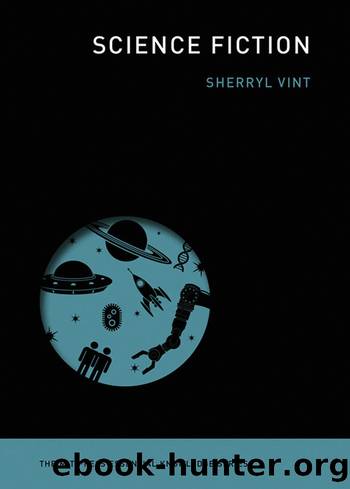Science Fiction by Sherryl Vint

Author:Sherryl Vint [Vint, Sherryl]
Language: eng
Format: epub
Tags: social change; artificial intelligence; genomics; climate change; utopian; colonial; colonialism; robotics; futurology;
Publisher: MIT Press
Published: 2021-01-22T00:00:00+00:00
The microbiome is not yet as prominent a theme in sf as genetic engineering or cloning, but it is also a more recent scientific framework.
In chapter 5, I discussed the relationship between sf texts about human-machine integration and a discourse of transhumanism that has become mainstream in the twenty-first century. The texts discussed in this chapter, about the human/nonhuman boundary and about how biotechnology is changing what it means to be human and challenging the premises of humanism, are related to a discourse called posthumanism. Initially transhumanism and posthumanism were used somewhat interchangeably, but more recently a differentiation has taken hold: transhumanism describes discourses interested in transcending the limitations of human embodiment while posthumanism describes a range of approaches interested in decentering the human in our knowledge systems and questioning the historical privilege of the human.11 Work in posthumanism thinks differently about humanity and its relationship to other species and to materiality in general, drawing attention to the exclusion of many people from the category of âthe humanâ in our history, and reconceptualizing many of the philosophical ideas central to humanism, such as agency, consciousness, choice, and intelligence.
Posthumanism is not as tightly linked to sf as transhumanism, for which the genre functions as something like a how-to manual, but many theorists of posthumanism find themselves turning to sf for concrete examples of the new theoretical paradigms their work highlights. Similarly, posthumanist ideas are taken up by many scholars of sf in their readings of the genre. Donna Haraway, especially her hugely influential âA Cyborg Manifestoâ (1984), is the most prominent among these examples: she extensively uses sf texts to explore her theoretical ideas and her work has been used frequently by sf scholars, so much so that as early as 1991 sf critic Istvan Csicsery-Ronay Jr. dubbed her and Jean Baudrillard (who writes about the blurring of simulation with materiality) authors of âthe SF of theory.â12
Download
This site does not store any files on its server. We only index and link to content provided by other sites. Please contact the content providers to delete copyright contents if any and email us, we'll remove relevant links or contents immediately.
Call Me by Your Name by André Aciman(20349)
Ready Player One by Cline Ernest(14493)
How to Be a Bawse: A Guide to Conquering Life by Lilly Singh(7360)
Wiseguy by Nicholas Pileggi(5648)
The Kite Runner by Khaled Hosseini(5061)
On Writing A Memoir of the Craft by Stephen King(4847)
Audition by Ryu Murakami(4822)
The Crown by Robert Lacey(4710)
Call me by your name by Andre Aciman(4599)
Gerald's Game by Stephen King(4555)
Harry Potter and the Cursed Child: The Journey by Harry Potter Theatrical Productions(4427)
Dialogue by Robert McKee(4305)
The Perils of Being Moderately Famous by Soha Ali Khan(4156)
Dynamic Alignment Through Imagery by Eric Franklin(4099)
Apollo 8 by Jeffrey Kluger(3621)
Seriously... I'm Kidding by Ellen DeGeneres(3564)
The Inner Game of Tennis by W. Timothy Gallwey(3557)
How to be Champion: My Autobiography by Sarah Millican(3544)
Darker by E L James(3463)
